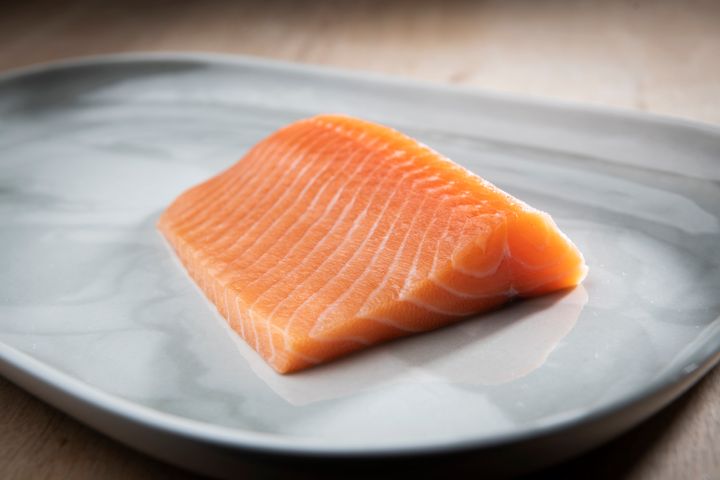The status of fillet colour in Norwegian farmed salmon
Nofima has mapped the status of and what could pose pigmentation challenges in salmon fillets among Norwegian fish farmers. According to Nofima scientists, the mapping also provides insights into some solutions that can be pursued further.

Nofima has mapped the status of and what could pose pigmentation challenges in salmon fillets among Norwegian fish farmers. According to Nofima scientists, the mapping also provides insights into some solutions that can be pursued further.
The investigation reveals the negative effect that repeated mechanical delousing has on fillet colour. This effect has not been documented before and could be caused by several factors. It may be due to increased consumption of an antioxidant like astaxanthin when the fish are stressed. However, it could also be that reduced feed intake results in lower slaughter weight, which is of great importance in relation to fillet colour. If fish are slaughtered at a lower weight to avoid more delousing, this will have a further negative effect on colour.
The findings are based on questionnaires answered by Norwegian industry actors in 2023, data on fillet colour from commercial productions between 2012 and 2023, and from Nofima’s R&D licenses. FHF – Norwegian Seafood Research Fund has funded the study, which has been carried out by Nofima senior scientist Trine Ytrestøyl and her colleagues.
“There is a high degree of correlation between what the fish farmers report in the questionnaire and what we observe affecting pigmentation in the data analysis, so there is reason to believe it provides a realistic picture of the situation,” says Ytrestøyl.
Variable scope of problems
Not all fish farmers perceive inadequate fillet colour as a problem. Some report a reduction in pigmentation in 2 percent of slaughtered fish, while others indicate problems with 20-40 percent of the slaughtered fish.
There is also variation in their target for the lowest acceptable colour, ranging from 24 to 27 on the SalmoFan scale and between 5 and 7 milligrams of astaxanthin per kilogram of fillet.
Historical data show that the colour intensity of Norwegian salmon has decreased somewhat from 2012 to 2021, with a slight increase after this period. There is also more variation in fillet colour now than in the past, which supports the results of the questionnaire: some fish farmers struggle more with pigmentation than others.
Measures require planning and minimal lice
Almost all respondents had taken measures to improve pigmentation. There is more astaxanthin in the feed (50-70 mg per kg) than before and some fish farmers also have more of the omega-3 fatty acids EPA and DHA as well as vitamins in the feed.
“This has had a positive effect, but it is expensive, and we have tried to find out what leads to inadequate pigmentation,” says Trine Ytrestøyl.
There are seasonal variations in pigmentation, and this can be taken into account when planning production. Very rapid growth resulted in poorer pigmentation, while the colour increased with greater slaughter weight. There was also a clear negative effect from many mechanical delousing treatments.
“This has not been shown before, although it has been mentioned as a possible cause of poor fillet colour.”
What surprised the scientists was the significant difference in colour at slaughter between suppliers of hatchery fish. They want to investigate this further to determine what impact the hatchery phase has on pigmentation levels when the fish are slaughtered.
The mapping includes a range of data that is useful for fish farmers to examine more closely.
Keywords
Contacts
Reidun Lilleholt Kraugerud
Tel:48197382reidun.lilleholt@nofima.noTrine Ytrestøyl
Tel:412 29 744trine.ytrestoyl@nofima.noImages
Documents
About Nofima
The Norwegian food research institute Nofima provides research based knowledge and innovations for actors in all parts of the food systems.

Subscribe to releases from Nofima
Subscribe to all the latest releases from Nofima by registering your e-mail address below. You can unsubscribe at any time.
Latest releases from Nofima
Three months shorter production time11.12.2025 07:00:00 CET | Press release
Selective breeding is a powerful tool to enhance desirable traits in fish and livestock - a fact well established in the industry. Now Manila clam has its own dedicated breeding programme.
Tre måneder kortere produksjonstid11.12.2025 07:00:00 CET | Pressemelding
At avl er et kraftfullt verktøy for å få fremgang i egenskaper man ønsker hos fisk og dyr, er kjent. Nå har teppeskjell fått sitt eget avlsprogram.
Potential for land based red algae25.11.2025 10:39:15 CET | Press release
How could Norway produce more food, utilise high nutrient levels in discharge water and create new businesses?
Potensiale for landbasert rødalge25.11.2025 07:00:00 CET | Pressemelding
Hvordan kan Norge produsere mer mat, rense utslippsvann og skape nye arbeidsplasser?
Norsk sjømatnæring: Nå er ringvirkningene større enn kjernevirksomheten13.11.2025 14:00:00 CET | Pressemelding
Ringvirkningene er nå større enn kjernevirksomheten i sjømatnæringen. Verdiskapingen i sjømatnæringens kjernevirksomhet utgjorde 69 milliarder kroner i 2024, mens ringvirkningene var nesten 70 milliarder.
In our pressroom you can read all our latest releases, find our press contacts, images, documents and other relevant information about us.
Visit our pressroom

